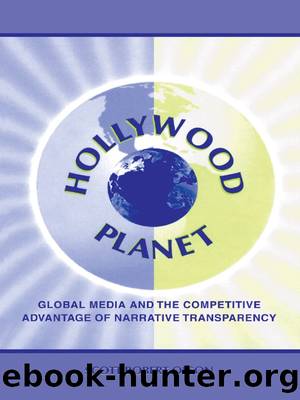Hollywood Planet by Scott Robert Olson

Author:Scott Robert Olson [Olson, Scott Robert]
Language: eng
Format: epub
ISBN: 9780805832303
Barnesnoble:
Publisher: Taylor & Francis
Published: 1999-05-01T00:00:00+00:00
Negentropy
Kubey and Czisktemaholy (1990) proposed one of the most compelling observational and theoretical explanations of how the media can become a virtual reality for its audience. They used the term negentropy to describe the psychological pull that television has on particular members of its audi-enceââthe amount of order it produces in [their] consciousnessâ (p. 4). Television becomes a mechanism for conveying sense and meaning in a world that otherwise appears senseless and meaningless. For heavy users, the media create a redundancy that continually reinforces for them âwhat is âreal/ what is worth paying attention to, working for, and living forâ (p. 182). Yet, this reality is a constructed one, a replacement for a reality based on human interaction, a model rather than the thing itself, a signifier instead of what is signified.
Tichi (1991) reinforced the Kubey and Czisktemaholy (1990) thesis in her examination of the use of television as a synthetic environment. Her interest was the extent to which the whole environmentâthe dominant culture found in advertising, the fine arts, journalism, and other placesâis influenced by television. An examination of these artifacts reveals that television has helped create an environment in which it is the dominant cultural determinant. Consequently, television has become naturalizedâthe behavior of its characters and the environment in which they live insinuate themselves into American beliefs and attitudes and come to seem normal.
Perhaps the primary reason why the visual media are so good at confeirring a sense of negentropy to the viewer is that most of what is seen on tele-vision or the movie screen operates comfortably within the bounds of genre and formula fiction. Cawelti (1976) argued that formulae in fiction are something that the reader comes to expect. According to Cawelti, âthe formula creates its own world with which we become familiar by repetition. We learn in this way how to experience this imaginary world without continually comparing it with our own experienceâ (p. 10). This reinforcement, then, functions the way myths do, which are themselves highly formulaic. The cognitive appeal of formulaic narrative for its audience is that it constructs âan ideal world without the disorder, the ambiguity, the uncertainty, and the limitations of the world of our experienceâ (p. 13). Formula, like myth, conveys order.
Because of its natural tendency to think in categories (Lakoff, 1987), the human mind is naturally drawn to formula fiction, genres, and myths, and all forms of generic presentation. Indeed, categories have been a preoccupation of the human mind at least since Aristotle, as has genre. Familiar story lines and archetypes in the American cinema perfectly address this preoccupation:
The meaning of an image is not only produced on the basis of the reality (or the impression of reality) expressed in it. The meaning also emerges from the relationship between this image and others that the audience has already seen. This process of interaction and exchange constantly nourishes memory of the American image industry. (Mattelart et al., 1984, p. 95)
Download
This site does not store any files on its server. We only index and link to content provided by other sites. Please contact the content providers to delete copyright contents if any and email us, we'll remove relevant links or contents immediately.
The Secret History by Donna Tartt(16717)
The Social Justice Warrior Handbook by Lisa De Pasquale(11506)
Thirteen Reasons Why by Jay Asher(7831)
This Is How You Lose Her by Junot Diaz(5827)
Weapons of Math Destruction by Cathy O'Neil(5077)
Zero to One by Peter Thiel(4867)
The Myth of the Strong Leader by Archie Brown(4809)
Promise Me, Dad by Joe Biden(4477)
Beartown by Fredrik Backman(4464)
How Democracies Die by Steven Levitsky & Daniel Ziblatt(4447)
Stone's Rules by Roger Stone(4438)
The Fire Next Time by James Baldwin(4371)
100 Deadly Skills by Clint Emerson(4106)
A Higher Loyalty: Truth, Lies, and Leadership by James Comey(4059)
Rise and Kill First by Ronen Bergman(4043)
The David Icke Guide to the Global Conspiracy (and how to end it) by David Icke(3913)
The Farm by Tom Rob Smith(3893)
Secrecy World by Jake Bernstein(3806)
The Doomsday Machine by Daniel Ellsberg(3757)
